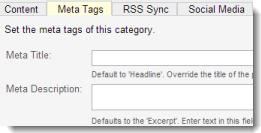Once you have identified meaningful keywords for your website, an important starting point is to define SEO for all web pages on your site through Global Settings. After this is complete, you should then define SEO at the article, product, and category levels.
Default Global SEO Settings
Meta Title
Sets a global, default title for all web pages on your site. The Title attribute displays on a webpage’s browser tab and appears as the first line of Google Search results. For better search engine results, the Title attribute can and should be defined for each page, article and product of your website.
Meta Description
Sets a global, default Meta Description for all web pages on your site. The Meta Description attribute is displayed under the Title in search engine results. For better click through rates, the Meta Description attribute can and should be defined for each page, article and product of your website.
Meta Head
Sets global header tags to add to the top of all your webpages. Examples: Meta tags for website validation in Yandex and other search engines, or custom scripts that will execute on all pages. DO NOT enter the Google Tracker code in this field – use the Google Tracker field.
Optimizing SEO for articles, products, members and forms
Refining the URL, Page Titles and H1 Tags and item meta tags will maximize your “searchability.”
Short URL
Use the URL field to create short, descriptive URLs containing keywords. For example, if you sell candles, the article URL new-fragrance-free-candles is more beneficial than new-products.

See SEO Training Article 1 - Keywords for tips.
Maximizing Page Titles for SEO
Page titles are a great opportunity to maximize SEO.
- Use a keyphrase in your title corresponding to a phrase most people are likely to type to find your content. You can use Google Adwords tools to help you determine which phrases are effective.
- Limit the title to 60 characters, which is the space allotted in browser title windows. If you need to say more, use the Meta Description field.
Maximizing Headings (H1 tags) for SEO
The Headline field in articles, events, products and business listings is the H1 tag and provides a great opportunity to reinforce and maximize SEO. Recommendations for using Headlines to enhance SEO follow:
- A Headline is required. Create a Headline relevant to your article, event, etc. Don’t use a generic heading.
- Do not try to trick search engines by using a headline that is irrelevant to your content. For example, a winery website using a headline to promote the benefits of a pharmaceutical drug can be red-flagged by search engines.
HTML restricts each page to one H1 tag, so take advantage of the opportunity to maximize SEO.
Meta Tags
Click on the Meta Tags tab in the item you want to edit (article, product, etc.)
Meta Title
Meta Titles correspond to Google’s blue links in search results and enable your pages to be found more effectively in searches. The Meta Title should briefly describe what the page is about. Try to keep the text to 70 or fewer characters.
Meta Description
Meta Descriptions provide additional page level information so your page can be found in searches. The Meta Decription corresponds to the text displayed under the blue link in Google search results. In the Meta Description, try to describe what the page is about in about two sentences or 150 characters.

Maximizing SEO for Categories
If you use category pages to display your content (articles or products) in hyperlinked lists, there are SEO options you can define to maximize your SEO for the category.
Click on the Meta Tags Tab to edit
Meta Title
The Meta Title should briefly describe what the product category is about.
Meta Description
A Meta Description provides additional category level information so your product category can be found in searches.


